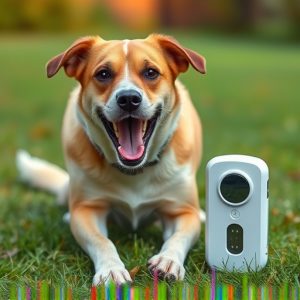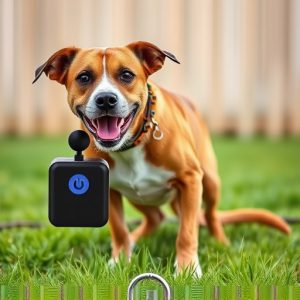Prevent Dog Attacks: Safe Power & Effective Deterrents for Electronics
Dogs may exhibit aggression towards electronic devices due to sensory overload or fear of unknown st…….
Dogs may exhibit aggression towards electronic devices due to sensory overload or fear of unknown stimuli. To prevent attacks, owners should recognize discomfort signs, keep electronics at safe power levels, and ensure supervision. Gradual exposure and positive reinforcement can reduce aggression. Safe power levels for dog deterrents are crucial, as they discourage dogs without causing harm. Modern solutions use technology to disrupt a dog's sensory perception, fostering positive associations with electronic devices. Training and behavioral modifications, including positive reinforcement and consistent sessions, prevent dog attacks. For severe cases, professional guidance from canine experts is recommended.
In recent years, incidents of dog attacks on electronic devices have risen dramatically. This article delves into understanding why dogs may exhibit aggression towards tech gadgets, focusing on key strategies for prevention and safety. We explore the critical role of safe power levels in device design as a primary deterrent, alongside effective training methods and behavioral modifications to foster a harmonious coexistence between pets and technology. Learn how these steps can help keep both your dog and your devices secure.
- Understanding Dog Aggression Towards Electronic Devices
- The Role of Safe Power Levels in Prevention
- Implementing Effective Dog Deterrents for Electronics
- Training and Behavioral Modifications for a Safer Experience
Understanding Dog Aggression Towards Electronic Devices
Dogs, like any animals, can display aggression towards unfamiliar objects or stimuli, and electronic devices are no exception. Understanding this behavior is the first step in preventing dog attacks. When a dog approaches an electronic device with aggression, it’s often due to sensory overload or fear of the unknown. Modern gadgets emit lights, sounds, and vibrations that might be overwhelming for some canines. Additionally, the sudden movement or flashing images on screens can trigger a protective response in dogs, leading to growling, snarling, or even biting.
Training owners to recognize these signs of discomfort is crucial. Ensuring that electronic devices are used at safe power levels and not left unattended around dogs can act as an effective deterrent. Teaching dogs positive associations with the devices through gradual exposure and rewarding calm behavior can also help reduce aggression. In fact, utilizing a dog’s natural curiosity in a controlled manner could be a game-changer in fostering a peaceful coexistence between man’s best friend and technology.
The Role of Safe Power Levels in Prevention
When considering electronic devices designed to deter dog attacks, one critical aspect often overlooked is the concept of safe power levels. These devices utilize a range of technologies, from ultrasonic sounds to light stimuli, to create an unpleasant experience for approaching dogs without causing them harm. The effectiveness of these methods relies heavily on ensuring the power output remains at safe levels, both for the dog’s well-being and to avoid any potential legal issues.
Safe power levels mean that the device’s intensity should be set below the threshold that could cause physical or psychological damage to the animal. It is essential to respect the guidelines and recommendations provided by manufacturers and experts in canine behavior to ensure these devices serve their purpose without endangering pets or violating local regulations regarding animal welfare. By adhering to safe power levels, dog deterrents can be a responsible and effective solution for keeping dogs at bay.
Implementing Effective Dog Deterrents for Electronics
Implementing effective dog deterrents for electronics involves finding safe power levels that can discourage canine attacks without causing harm. Traditional methods like strong-smelling sprays or high-pitched sounds have shown varying success, often relying on startle responses rather than sustained aversion. Modern solutions offer more nuanced approaches, leveraging technology to emit specific frequencies or vibrations that disrupt a dog’s sensory perception of the electronic device.
These innovative dog deterrents focus on safe power levels to prevent any potential injury to the pet. By targeting their heightened senses, such as hearing or smell, these devices can teach dogs to avoid certain objects or areas. For instance, some advanced systems use controlled ultrasonic emissions that are inaudible to humans but irritating to dogs, creating a positive association of discomfort with the presence of electronic devices. This approach not only discourages attacks but also promotes a safe and harmonious coexistence between pets and technology.
Training and Behavioral Modifications for a Safer Experience
Training and behavioral modifications are key strategies to prevent dog attacks on electronic devices, ensuring a safer experience for both humans and pets. By employing positive reinforcement techniques, owners can teach their dogs to associate electronic devices with pleasant experiences rather than potential threats. This involves introducing the device at safe power levels and rewarding calm behavior with treats or praise. Consistency is vital; regular sessions focused on desensitization and reward can significantly improve a dog’s response over time.
Additionally, creating a positive association between the device and the owner’s presence can deter aggressive behavior. Incorporating playtime and training sessions around the device helps strengthen this bond. It’s essential to remember that each dog is unique; professional guidance from a canine behaviorist or trainer may be necessary for more severe cases. These experts can tailor strategies to address specific behavioral issues, ensuring a safer coexistence between dogs and the electronic devices they might encounter.
In conclusion, preventing dog attacks on electronic devices requires a multi-faceted approach. By understanding canine aggression towards these devices, utilizing safe power levels, and implementing effective deterrents alongside training and behavioral modifications, pet owners can create a safer environment for both their pets and technology. Remember that proactive measures, such as maintaining Safe Power Levels in electronics, are key to preventing unwanted incidents and fostering a harmonious relationship between dogs and their digital surroundings.


